Recreational vehicle
A recreational vehicle, often abbreviated as RV, is a motor vehicle or trailer which includes living quarters designed for accommodation.[1] Types of RVs include motorhomes, campervans, caravans (also known as travel trailers and camper trailers), fifth-wheel trailers, popup campers and truck campers.
Features

Typical amenities of an RV include a kitchen, a bathroom, and one or more sleeping facilities. RVs can range from the utilitarian – containing only sleeping quarters and basic cooking facilities – to the luxurious, with features like air conditioning (AC), water heaters, televisions and satellite receptors, and quartz countertops, for example.
RVs can either be trailers (which are towed behind motor vehicles) or self-motorized.[2] Most RVs are single-deck; however, double-deck RVs also exist. To allow a more compact size while in transit, larger RVs often have expandable sides (called slide-outs) or canopies.
History
An early type of caravan is the horse-drawn covered wagon, which from circa 1745 played a significant part in opening up of the interior of the North American continent to white settlement. By the 1920s the RV was well established in the United States, with RV camping clubs established across the country, despite the unpaved roads and limited camping facilities.[3] Several companies began manufacturing house trailers (called trailer coaches at the time). Airstream is one such company. Until the 1950s, the RV industry was closely connected to the mobile home industry because most mobile homes were shorter than 9 metres (30 ft) long, and thus easily transportable. During the 1950s, the RV and mobile home industries became separated and RV manufacturers began building self-contained motorhomes.
In Europe, wagons built for accommodation (rather than just transporting people or goods) were developed in France around 1810. They were used in Britain by showmen and circus performers from the 1820s. Romani people only began living in caravans (vardos) circa 1850.
In Canada, the earliest motorhomes were built on car or truck bodies from about 1910.
In Australia, the earliest known motorhome was built in 1929. This motorhome is recognized as being the first motorized caravan in Australia and is currently located in the Goolwa museum.
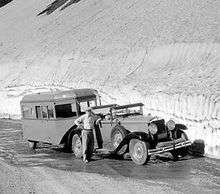 1933 car and tourist observation trailer
1933 car and tourist observation trailer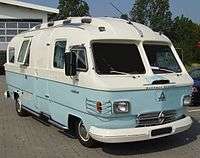 1970s Hanomag-Henschel Orion
1970s Hanomag-Henschel Orion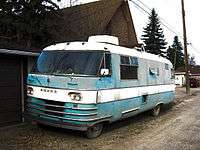 1970s Dodge Travco
1970s Dodge Travco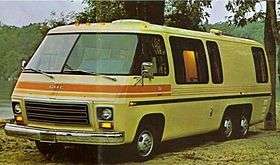 1973 GMC Motorhome
1973 GMC Motorhome
Recreational vehicle industry
In U.S., about 85 percent of recreational vehicles sold are manufactured in Indiana,[4] and roughly two-third of that production in the Elkhart County, which calls itself "the RV Capital of the World", population 206,000. The industry has US$32.4 billion annual economic impact in Indiana, pays US$3.1 billion in taxes to the state and supports 126,140 jobs and US$7.8 billion in wages, according to the RV Industry Association.[5]
The recreational vehicle industry around Elkhart is part of a large network of related transport equipment companies, including utility trailer makers and specialty bus manufacturers, who source from the same supply chains.[4] The industry has taken hits from U.S. tariffs on steel and aluminum and other duties on RV parts made in China, from plumbing fixtures to electronic components to vinyl seat covers. Tariff-related price hikes have forced manufacturers to pass on some of the increased costs though higher RV prices, which in turn has contributed to slower sales.[4] Shipments of RVs to dealers have fallen 22% percent in the first five months of 2019, compared to the same period last year, after dropping 4% in 2018.[4]
Usage
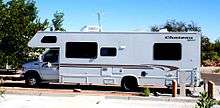
.jpg)
Although the most common usage of RVs is as temporary accommodation when traveling, some people use an RV as their main residence. In the United States and Canada, travelling south each winter to a warmer climate is referred to as snowbirding. In Australia, the slang term for a retired person who travels in a recreational vehicle is a "grey nomad".[6]
Some owners fit solar panels to the roof of their RV.[7]
Usage of RVs is common at rural festivals such as Burning Man.[8]
Moisture and condensation
Moisture is not an uncommon problem in RVs. The main sources of moisture is breathing from the users of the van, as well as water vapor from any indoor cooking or drying of clothes. Rain water entering the RV can also sometimes be a cause of moisture.
Too high humidity can result in a poor indoor climate. In addition, the moisture will usually condensate on the windows since these usually are the coldest surfaces inside the vehicle. The condensation then tend to drip down onto the window frame, and can drip further into the wall in case the window frame is not sufficiently waterproof, potentially causing a growth of mold.
Measures for bringing the moisture in an RV down are similar to those done for apartments, which are aeration and ventilation combined with heating. Doing cooking and drying of clothes outdoors may also help. A dehumidifier can be put into the RV in order to lower the humidity, but will not remove the underlying cause and as such can often be viewed as a temporary solution. It should be mentioned that extra thermal insulation seldom is a practical solution in RVs, since there seldom is enough space to make the insulation thick enough to prevent condensation and associated mold growth.
Demographics
As of 2016, the average age of a person owning a recreational vehicle in the United States was 45, with a three-year decrease since 2015.[9]
See also
References
- "Recreational Vehicle". www.fema.gov. Retrieved 4 March 2018.
- <www.autotrader.ca/newsfeatures/20160728/beginners-guide-to-buying-an-rv/>
- "The brief history of RVs in America and the world". WM-AW based upon RV/MH Heritage Foundation. Retrieved 10 June 2017.
- Aeppel, Timothy (18 July 2019). "Trump's tariffs trip up the all-American RV industry". Reuters. Retrieved 19 August 2019.
- Burris, Alexandria (19 August 2019). "Recession fears are rising. Here's the status of economic bellwether Elkhart, Indiana". Indianapolis Star. Retrieved 19 August 2019.
- "grey nomad". thefreedictionary.com.
- Wittbrodt, Ben; Laureto, John; Tymrak, Brennan; Pearce, Joshua M. (2015), "Distributed manufacturing with 3-D printing: A case study of recreational vehicle solar photovoltaic mounting systems", Journal of Frugal Innovation, 1 (1), doi:10.1186/s40669-014-0001-z
- "RVs". Retrieved 6 November 2014.
- Schultz, E.J. (19 March 2018). "Young Wanderlust Gives New Life to RV Market". Advertising Age. Retrieved 20 March 2018.
Further reading
- Gallant, JD (2005). How to Select, Inspect, and Buy an RV. RV Consumer Group. ISBN 1890049-9-05.
- Freeman, Jayne (2005). The Complete RV Handbook. McGraw-Hill Professional. ISBN 978-0-07-144339-5.
- Moeller, Bill (2007). The Complete Book of Boondock RVing: Camping Off the Beaten Path. McGraw-Hill Professional. ISBN 978-0-07-149065-8.
- "Hitting the Trail 1935 Style". Popular Mechanics. July 1935. pp. 40–42.
External links
